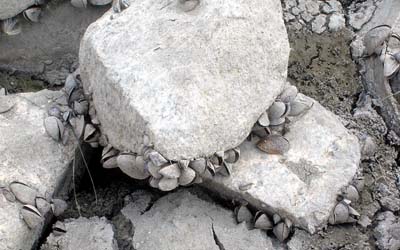
Various agencies are considering use of potash and chlorine to
treat San Justo Reservoir’s zebra mussel infestation, the only in
California to date, and will hold a meeting May 26 where the public
can get involved in the project. San Justo Reservoir just outside
of Hollister has been closed since January 2008 when the species
was discovered there.
HOLLISTER
Various agencies are considering use of potash and chlorine to treat San Justo Reservoir’s zebra mussel infestation, the only in California to date, and will hold a meeting May 26 where the public can get involved in the project.
San Justo Reservoir just outside of Hollister has been closed since January 2008 when the species was discovered there. This particular non-native species can wreak havoc on the ecosystem and water distribution pipeline by clogging it.
Such infestations have cost millions of dollars to treat in other areas of the country, while officials must be particularly wary in this case about the mussels potentially spreading throughout the Central Valley water system connecting to San Justo.
An array of treatment methods have been attempted. Only one in the country has been wholly successful in eradicating these mussels, noted Jeff Cattaneo, head of the San Benito County Water District.
If unsuccessful here, he said the federal, state and local officials involved can merely try to keep the population controlled “to keep them at a minimum in the distribution system.”
As for the eradication method proposed by the U.S. Bureau of Reclamation, to be discussed at the 6 p.m. meeting at the County Administration Building, it involves using a solution of potash and chlorine. A press release from the federal agency notes how potash is a natural compound and chlorine is a disinfectant commonly used in potable water systems.
Officials propose to draw down the water level, infuse the remaining supply with potash, and treat the distribution system with a solution of potash and chlorine, according to the federal agency.
They also plan to take special precautions for threatened California red-legged frogs in the pond at the base of the dam that receives seepage water, according to the statement. When they draw down the reservoir, they would replace the seepage water normally received by the pond with untreated water.
Until the proposal moves forward, which might happen as early as this fall, the San Justo Reservoir will remain closed to the public. It has been closed ever since the discovery, and no other activity has been happening there.
“It has been a big loss for us,” said Susan Thompson, the county administrative officer. “It was a recreational outlet that was inexpensive and it was really, heavily frequented by families. That’s a huge loss for us.”







